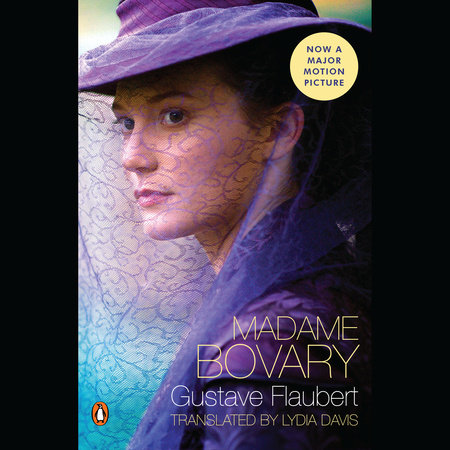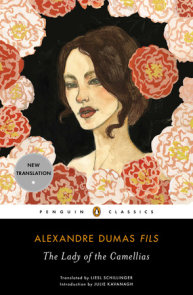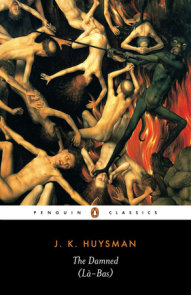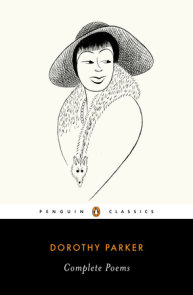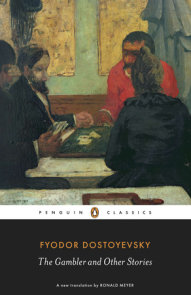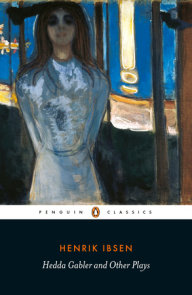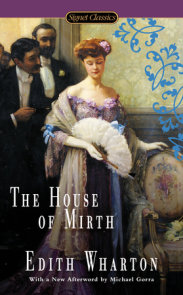READERS GUIDE
Questions and Topics for Discussion
INTRODUCTION
When Charles Bovary first meets his future wife Emma, she is resting in the parlor of her father’s farmhouse surrounded by bags of wheat and the incongruous images of oriental and mythological figures. This is not, we are invited to think, your typical farmer’s daughter. Here is a young woman whose imagination feeds on Turks and Olympian gods. Charles, on the other hand, responds to more common motives. Already married at this point in the novel, he has come to mend Emma’s father’s broken leg. Reflecting on his meeting with Emma a page later he attempts to explain away his aroused interest by attributing “his zeal to the gravity of the case, or perhaps to the profit he hoped to make from it” (p. 15). In fact, the narrator introduces this reflection as a hypothetical by prefacing it with “Had he thought of it.” Charles seems to lack even the imagination and curiosity to investigate his feelings of arousal. This brief scene with its suggestion of adultery and with the mismatched imaginative faculties of its two actors foreshadows the disastrous union the two will soon make.
Charles’s thoughts of profit also introduce a central theme in the novel: the entanglement of love and money. Money is inscribed in most of the marriages in the novel. When Charles’s first wife dies and her legacy is discovered to be a fraction of what was promised, the Bovary parents are outraged. Later Emma’s father accepts Charles as a suitor because, inter alia, he “would probably not haggle too much over the dowry” (p. 21). Flaubert even hints at this relationship in his choice of name. Bovary with its echo of “bovine” suggests that Emma, or any marriageable woman, is akin to a dairy cow to be traded and bartered with. Readers should remember that Madame Bovary was written in the mid-nineteenth century when marriage was more of an economic contract than a relationship based on love or emotional compatibility. The tension between the claims of conventional marriage and amorous love has been exploited by poets and novelists since the Middle Ages but it was the Romantic movement in the early nineteenth century that first challenged conventional assumptions for a wide reading public. Emma, demonstrably part of that reading public, spends most of her life rebelling against societal expectations and searching for an enduring passionate relationship. These designs, alas, end in disappointment when her lovers show as much petty concern with money and status as any of the ordinary townsfolk. The most poignant twining of love and money is the fact that Emma is quite literally killed by broken promissory notes: those promises of a new life in Italy betrayed by Rodolphe, and those lines of credit she is unable to repay the evil merchant Lhereux. Both betrayals of trust converge at the novel’s end leaving Emma seemingly without any hope.
Emma’s refusal to accept the conventions of marriage is part and parcel of her rebellion against the oppressively dull world of the petit bourgeois. As Emma confides in the young law student Leon, “I detest common heroes and moderate feelings, the sort that exist in real life” (p. 73). And no one better epitomizes that dull middle class and its obsessions with money and social status than the pharmacist Homais. Despite interfering with and bungling several medical procedures, despite being directly responsible for the wrongful sentencing of a poor vagabond, and despite being implicated in Emma’s suicide, at the novel’s end Homais receives the vaunted cross of the Legion of Honor. The irony of Homais’s success is not lost on Emma who goes in search of people more worthy of the mantle of heroism. Her first lover Rodolphe seems at first to walk out of the pages of a Sir Walter Scott novel when he says to Emma “In fact there are two moralities . . . the conventional one, the one devised by men. . . . But the other one, the eternal one, is all around and above us, like the landscape that surrounds us and the blue sky that gives us light” (p. 126). Rodolphe, who proves to be a cad, simply employs poetic language in the service of seduction. Later in the novel, after her affair with Rodolphe fades, a more jaded and withered Emma begins to see the false seductions of art and life. At the opera, seeing an adaption of Scott’s novel The Bride of Lammermoor, “She now knew the pettiness of the passions which art exaggerated” (p. 197). Both art and life, she realizes, are inadequate in their own ways.
Unfortunately, she encounters her old flame Leon and quickly forgets the hard-won lessons about the dangers of mixing art and life. Their affair ends similarly in disappointment. In fact, most human endeavors in the novel end in monotonous tedium. Lassitude, a word borrowed from the French, is repeated numerous times in the novel; even Charles utters the word once. No sooner is Emma married than she becomes “thoroughly disillusioned” with marriage (p. 34), and Charles’s passionate love for her falls into a predictable pattern, “like a dessert course foreseen in advance, after the monotony of dinner” (p. 37). The repetitiousness of life gnaws at even the promising young law student Leon who declaims “How bored I am!” (p. 83). Shortly after their first passionate embrace, Emma and Rodolphe behave “like a married couple calmly tending a domestic flame” (p. 149). Rodolphe, no less vain or shallow than most other characters, nonetheless is associated with the novel’s most profound meditation on the nature of love and desire: “the charm of novelty, slipping off gradually like a piece of clothing, revealed in its nakedness the eternal monotony of passion” (p. 167). The novel suggests that all human relationships, all of life’s most arousing moments eventually end in unbearable tedium.
Tedium hardly makes for interesting reading. But this was the challenge Flaubert, encouraged by his friend Louis Bouilhet, explicitly presented to himself. Instead of drawing upon the exotic material of myth or ancient history, Flaubert chose the very prosaic story of adultery set in an ordinary provincial village. The novel’s success would rest not on its subject matter but on its formal beauty, its style. Flaubert enhances the theme of tedium in a number of ways, including in the coupling of scenes. For example, the seduction of Emma by Leon against the backdrop of the church and its prattling cleric parallels the earlier seduction by Rodolphe against the inane speeches of the officials at the agricultural fair. At the end of part II Emma is read her last rites; at the end of part III she is pronounced dead. Flaubert’s choice of verb tense also calls attention to the theme of repetitiousness. As Lydia Davis notes in her introduction, Flaubert often employs the imparfait, or imperfect tense, which describes a repeated rather than a completed action. Finally, the novel’s recurring imagery highlights the enervating monotony of its characters’ lives. No more affecting or haunting image is that of the vessel subjected to the repetitively rocking forces beyond its control. The carriage ride that whirs around in circles as Emma and Leon consummate their relationship; the image of “an empty cask carried out to sea and rolling about in the waves,” (p. 161) to which Charles compares himself in a state of psychological duress; the image of the “vessel pitching” (p. 180), used to describe a reeling Emma after seeing Rodolphe’s farewell letter; the Bovary house, emptied by Lhereux’s creditors; the three caskets, each containing another empty vessel-these are but a few of the images which help tie the formal components of the novel together. The effect on the reader is not one of lassitude but of wonder and aesthetic pleasure.
ABOUT GUSTAVE FLAUBERT
Gustave Flaubert (1821-1880) was born in Rouen, France, the younger son of a provincial doctor. At age eighteen he was sent to study law in Paris but was afflicted with a mysterious nervous ailment and retired after only three years to live with his widowed mother. Supported by a private income, he devoted himself to his writing. The success of Madame Bovary, his first novel, was ensured when it was deemed immoral by the French government. Flaubert went on to write Salammbô, Sentimental Education, and Three Tales, and his fame and reputation grew steadily after his death with the publication of his unfinished comic masterpiece Bouvard and Pécuchet and the many remarkable volumes of his correspondence.
ABOUT LYDIA DAVIS
Lydia Davis is the author of one novel and seven story collections, the most recent of which was a finalist for the 2007 National Book Award. Her stories were recently brought together in one volume, The Collected Stories of Lydia Davis, which was selected as a best book of 2009 by The New York Times Book Review, Los Angeles Times, and San Francisco Chronicle. In 2003 she was awarded the French-American Foundation Translation Prize for her translation of Marcel Proust’s Swann’s Way. She won the prize again in 2011 for her translation of Madame Bovary. Her other honors include a MacArthur Fellowship and a Chevalier de l’Ordre des Arts et des Lettres by the French government for her fiction and her translations. She lives near Albany, New York.
A CONVERSATION WITH LYDIA DAVIS
Q. You mentioned that you had examined Flaubert’s working drafts of Madame Bovary. As a novelist yourself, did you disagree with any of Flaubert’s final editorial decisions? Were you especially perplexed by any?
I was usually too intent on discovering the history of certain passages, and often the answer to some puzzle-why was Charles stamping his foot against the wall of his room?-to stand back and make a judgment about whether or not Flaubert should have done what he did in a particular sentence. But his earlier drafts were almost always much longer, more descriptive, than his final versions-he would often cut whole pages-and although sometimes he left out some information that would have clarified the final passage, in general I would say his restraint, the fact that he kept the writing more economical and terse throughout the novel, gave it a greater emotional force.Q. In a recent interview, you said that you didn’t find Emma “admirable or likeable.” Could you elaborate on this? Has your opinion of her changed since your translation published?
As a reader of a novel, as you suspend your disbelief, you warm to a character or you don’t like-or you have mixed feelings, of course, just as you do about people in real life. Many readers of Madame Bovary do warm to Emma. My reaction to her, in the end, was mixed. It is hard not to feel some admiration and sympathy for a person so driven by desperation that she is brave enough to take her own life and who is thoughtful enough to examine her sensations as she is doing it. But of course she is not a real person, so I am at the same time reacting to Flaubert’s artistic skill in portraying her as she evolves through the course of the novel. As I translate, I generally have two reactions operating in tandem: the general reader’s reaction to the material of the novel, and at the same time a writer’s reaction to the problems posed by the text, the beauties of the text, and the satisfactions of the translation.Q. What was the single most difficult sentence, or word, in the novel to translate?
There are a number of words in French that are as useful to French sentence structure as they are difficult to translate, one of them being dont, meaning “of which,” “concerning which,” “about which,” etc. It would take me a page to explain how handy that word is in French for creating a graceful subordinate structure and how utterly graceless it is when translated literally into English. But as for sentences in Madame Bovary, one of the very hardest was one of the shortest: the sentence announcing Emma’s death: “Elle n’existait plus.” Literally, that would be: “She no longer existed.” But that is a tough one to write if you want it to have some emotional impact. In the end, I chose to translate it “She had ceased to exist”-which extended the original just a little. “She was no longer” would be another decent one, still within the parameters of a close translation. The temptation to step outside those parameters (which one occasionally has to do, of course) and to enhance the sentence, or to sentimentalize it or romanticize it-“she was gone”; “she had departed this life”-simply had to be avoided.Q. You confided that it took some persuading before you accepted the invitation to translate Madame Bovary. Why did you hesitate? Do you have plans for another translation project in the future?
When the suggestion was first made, I was still reeling from the enormous project of translating Proust’s Swann’s Way. I needed a long break. But when the suggestion came up again, I missed translating-the long, steady engagement with a superlative text, the opportunity both to solve a word puzzle and to write a good sentence in English-so I agreed to do it. I will probably not, however, take on another long translation project in the future, since I have a long project of my own under way.Q. Is there a particular aspect of Flaubert’s style you had hoped to convey in your translation? Do you think you were successful?
There are a couple of aspects of his style that I particularly admire, one being its economy and the other the beauty of the detail in his descriptions. By staying very close to the original text, especially to the order in which his sentences unfolded and to the material of the text itself-adding nothing and subtracting nothing-I think I did succeed in conveying both of these aspects to a large degree, though you always do lose something in a translation.Q. Many readers will inevitably compare this translation with your lauded translation of Proust’s Swann’s Way. Could you briefly characterize the differences in translating Flaubert and Proust?
In both cases, my attempt was to stay very close to the original text while writing English that was both natural and forceful. One difference was that in the case of the Proust, this was the first time I had worked so “deeply” on a text-I felt it deserved all the time I needed to take, and all the concentration on a single sentence or, often, a single word. One of the challenges in the Proust was to retain the elaborate constructions of the long sentences with their many subordinate clauses. But the extravagance and lyricism of his prose was a pleasure, and in his own way he is just as concise as Flaubert-there are many words, but no unnecessary ones. One of the main challenges in translating Flaubert was the opposite-to be as terse as he is, as in the example I gave above, of the announcement of Emma’s death, and make it work in English.Q. Does this novel mean something different to French readers today than Anglo-American ones? Is there something cultural that is inevitably lost in translation?
There will always be cultural associations that resonate for readers of the original text and are absent for readers of the translation, and a constant question for a translator is whether, and how, to attempt to reproduce or explain these associations. Some translators incorporate explanations “silently” in the text by adding an identification-for instance, “dance hall” in the reference “La Chaumière dance hall”; others substitute a more universal, and presumably more recognizable, reference for a more local one-for instance “Salome” in place of “Marianne dancing”; others retain the original text and supply explanations in footnotes. In the case of my translation, I retained the original text and supplied these explanations in the form of “blind” end notes-i.e. notes at the back of the book not signaled by any mark on the page of the novel. I have never liked the intrusion of scholarly apparatus in an edition of a novel that is not meant to be for the scholar so much as for the general reader. Some readers like this approach, while others would rather be alerted when there is a note at the back of the book.Q. Flaubert famously declared that “a good sentence in prose should be like a good line in poetry, unchangeable.” His exacting style and attention to detail must have put enormous pressure on you as a translator. Did you keep such pronouncements in mind as you worked? Do you think Flaubert himself was always faithful to such pronouncements? Does he ever prove to be a mere mortal?
I did not feel under greater pressure translating Flaubert than I did translating Proust or, years before, the novels and essays of Maurice Blanchot. Any really fine writer demands the same level of care from a translator. As for the “unchangeable” sentence-the task of the translator seems to involve just the opposite, an acceptance of the changeability of a sentence: first, there is the radical change of the sentence from French to English, then the testing of any number of possible alternatives in English until a satisfactory one is found. And if you look at the many previous translations of Madame Bovary, you will see how many different possibilities there are for every single sentence of the book-in the view of each translator, presumably, the best alternative. I do think that Flaubert’s many drafts show how carefully he worked to achieve the sentence that seemed uniquely right to him. And I don’t remember coming upon a sentence that seemed careless or clumsy, though I may be forgetting some. (There is general consensus, on the other hand, that entire novels of his were less compelling than Madame Bovary and certain stylistic approaches of his a mistake-but surely a conscientious choice on his part.)Q. Among the many previous translations of the novel, was there one in particular you had hoped to surpass in accuracy and readability?
My aim was simply to stay as close as possible to the original and at the same time to write an English version that would be fully alive. I admired many of the previous translations at many moments, and did not actively want to surpass any one in particular. In the case of the Proust, the situation was different, since there was really only one available previous translation, the C. K. Scott Moncrieff, and its style was quite different from, and unrepresentative of, the original-thus terribly misleading to the Anglo-American reader who wanted to experience Proust. I felt it was very important that it be replaced by a version closer to Proust.Q. The New York Times review of your translation, which referred to Emma as ”a covetous, small-minded woman, incapable of love,” stirred up a lot of reaction online and in print. Were you surprised how passionate readers feel about Flaubert’s heroine?
We are circling back to the second question, here. That description of Emma is not inaccurate, but it is incomplete, and, as I said, one can have sympathy even for a character who is not generally admirable. It is natural for readers to become emotionally involved in the story Flaubert is telling, and that is part of the pleasure; yet it is important to retain enough disbelief, at the same time, to enjoy what he is doing technically-in his sparklingly specific descriptions, his artful transitions, his balancing of thematic elements and motifs, his sly humor.
DISCUSSION QUESTIONS









